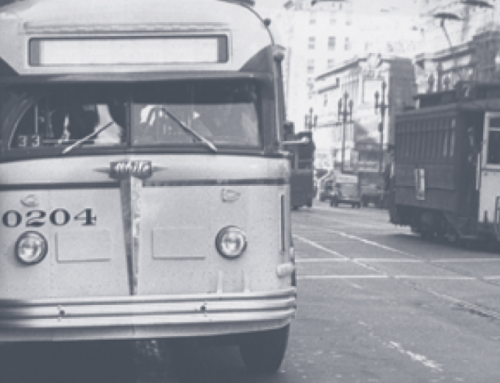In a constantly evolving field like transportation, it’s crucial for practitioners to be willing to shift perspective, or at least to rethink positions. What seems axiomatic in one period may change when new circumstances arise. Thus, for example, mid-twentieth-century advocacy of more roads to handle growing numbers of vehicles is being re-examined in the face of ever-increasing traffic congestion.
 Meanwhile new vehicle types slowly replace older ones; new types of buses share streets with old yellow school buses as well as hybrid cars and light rail; and our cities experiment with bus rapid transit, car sharing, traffic calming, and bike lanes.
Meanwhile new vehicle types slowly replace older ones; new types of buses share streets with old yellow school buses as well as hybrid cars and light rail; and our cities experiment with bus rapid transit, car sharing, traffic calming, and bike lanes.
There is no one-size-fits-all solution to our trans- portation problems; we try on and test fixes small and large. Some may be rejected presently as unworkable; some may stick around, long past their usefulness, until a new idea is more successful. And some may seem at first the perfect solution, only to later reveal they have created new, unanticipated problems. Meanwhile, change continues.
It’s hard for a modern citizen to believe, but the nineteenth century transportation mode of choice caused very serious congestion, pollution, and safety problems that seemed insurmountable. In these pages, Eric Morris details the remarkable consequences of using horses as the major means of transportation. Many readers will find his essay surprising. Parallels between today’s transportation and energy dilemmas and those of one hundred years ago will be easy to draw. Although society attacked the problems of horses on many fronts, the ultimate remedy seemed to come from nowhere: the modern motor car. A completely new transportation system transformed society in a relatively short time, and the woes  of the horse-transport era were quickly a thing of the past. Could solutions to current energy, pollution, and congestion problems come about in a similar way? Not having yet found any solutions, there’s no way we can know. But we can keep working on as many fronts as we possible. Daniel Kammen, in the Access Almanac, gives a brief but cogent look at one area that needs attention: support for research and development in energy issues.
of the horse-transport era were quickly a thing of the past. Could solutions to current energy, pollution, and congestion problems come about in a similar way? Not having yet found any solutions, there’s no way we can know. But we can keep working on as many fronts as we possible. Daniel Kammen, in the Access Almanac, gives a brief but cogent look at one area that needs attention: support for research and development in energy issues.
Donald Shoup is known to regular Access readers for explaining some of the repercussions of our parking systems over the years. He now has new information about how parking policies contribute to congestion— and by extension, to excess energy use and pollution— in our cities. Also in this issue, Sir Peter Hall ponders the future of transportation, his starting point firmly grounded in present day reality. Will buses, trains, or new technologies like private rapid transit eventually replace the automobile? And John Landis continues his sabbatical report, part two, with a look at Sydney’s transportation dilemmas and some of the solutions Australians are trying out.
—Melanie Curry
Editor






